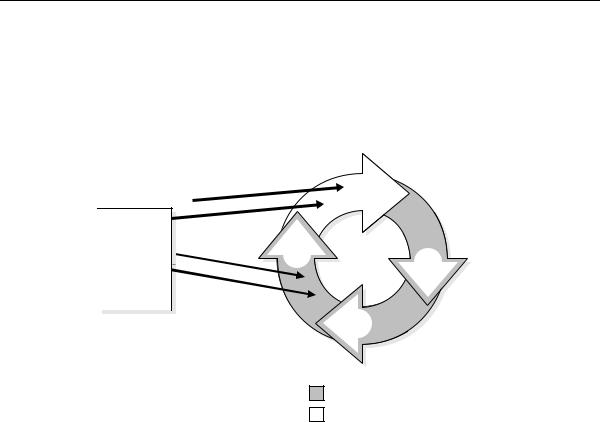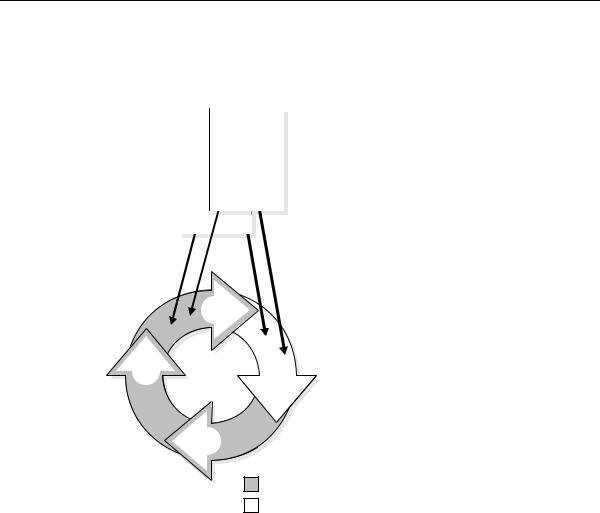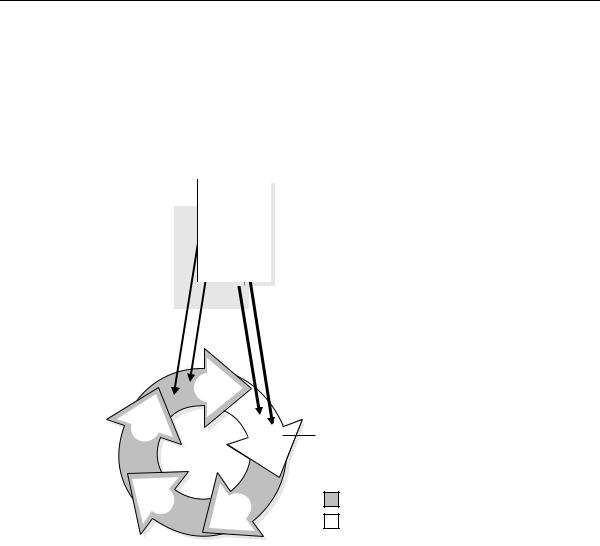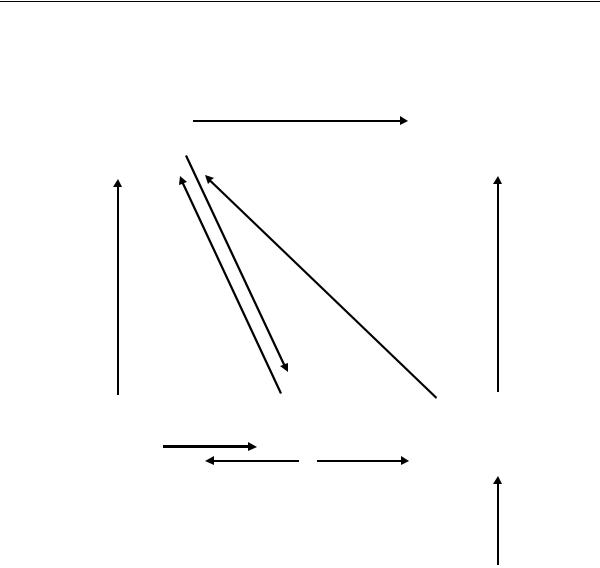
- •Contents
- •Send Us Your Comments
- •Preface
- •Audience
- •Organization
- •Related Documentation
- •Conventions
- •Documentation Accessibility
- •1 Introduction to the Oracle Server
- •Database Structure and Space Management Overview
- •Logical Database Structures
- •Physical Database Structures
- •Data Dictionary Overview
- •Data Access Overview
- •SQL Overview
- •Objects Overview
- •PL/SQL Overview
- •Java Overview
- •XML Overview
- •Transactions Overview
- •Data Integrity Overview
- •SQL*Plus Overview
- •Memory Structure and Processes Overview
- •An Oracle Instance
- •Memory Structures
- •Process Architecture
- •The Program Interface Mechanism
- •An Example of How Oracle Works
- •Application Architecture Overview
- •Client/Server Architecture
- •Multitier Architecture: Application Servers
- •Distributed Databases Overview
- •Replication Overview
- •Streams Overview
- •Advanced Queuing Overview
- •Heterogeneous Services Overview
- •Data Concurrency and Consistency Overview
- •Concurrency
- •Read Consistency
- •Locking Mechanisms
- •Quiesce Database
- •Database Security Overview
- •Security Mechanisms
- •Database Administration Overview
- •Enterprise Manager Overview
- •Database Backup and Recovery Overview
- •Data Warehousing Overview
- •Differences Between Data Warehouse and OLTP Systems
- •Data Warehouse Architecture
- •Materialized Views
- •OLAP Overview
- •Change Data Capture Overview
- •High Availability Overview
- •Transparent Application Failover
- •Online Reorganization Architecture
- •Data Guard Overview
- •LogMiner Overview
- •Real Application Clusters
- •Real Application Clusters Guard
- •Content Management Overview
- •Oracle Internet File System Overview
- •2 Data Blocks, Extents, and Segments
- •Introduction to Data Blocks, Extents, and Segments
- •Data Blocks Overview
- •Data Block Format
- •Free Space Management
- •Extents Overview
- •When Extents Are Allocated
- •Determine the Number and Size of Extents
- •How Extents Are Allocated
- •When Extents Are Deallocated
- •Segments Overview
- •Introduction to Data Segments
- •Introduction to Index Segments
- •Introduction to Temporary Segments
- •Automatic Undo Management
- •3 Tablespaces, Datafiles, and Control Files
- •Introduction to Tablespaces, Datafiles, and Control Files
- •Oracle-Managed Files
- •Allocate More Space for a Database
- •Tablespaces Overview
- •The SYSTEM Tablespace
- •Undo Tablespaces
- •Default Temporary Tablespace
- •Using Multiple Tablespaces
- •Managing Space in Tablespaces
- •Multiple Block Sizes
- •Online and Offline Tablespaces
- •Read-Only Tablespaces
- •Temporary Tablespaces for Sort Operations
- •Transport of Tablespaces Between Databases
- •Datafiles Overview
- •Datafile Contents
- •Size of Datafiles
- •Offline Datafiles
- •Temporary Datafiles
- •Control Files Overview
- •Control File Contents
- •Multiplexed Control Files
- •4 The Data Dictionary
- •Introduction to the Data Dictionary
- •Structure of the Data Dictionary
- •SYS, Owner of the Data Dictionary
- •How the Data Dictionary Is Used
- •How Oracle Uses the Data Dictionary
- •How to Use the Data Dictionary
- •Dynamic Performance Tables
- •Database Object Metadata
- •Introduction to an Oracle Instance
- •The Instance and the Database
- •Connection with Administrator Privileges
- •Initialization Parameter Files
- •Instance and Database Startup
- •How an Instance Is Started
- •How a Database Is Mounted
- •What Happens When You Open a Database
- •Database and Instance Shutdown
- •Close a Database
- •Unmount a Database
- •Shut Down an Instance
- •6 Application Architecture
- •Client/Server Architecture
- •Multitier Architecture
- •Clients
- •Application Servers
- •Database Servers
- •Oracle Net Services
- •How Oracle Net Services Works
- •The Listener
- •7 Memory Architecture
- •Introduction to Oracle Memory Structures
- •System Global Area (SGA) Overview
- •Dynamic SGA
- •Database Buffer Cache
- •Redo Log Buffer
- •Shared Pool
- •Large Pool
- •Control of the SGA’s Use of Memory
- •Other SGA Initialization Parameters
- •Program Global Areas (PGA) Overview
- •Content of the PGA
- •SQL Work Areas
- •PGA Memory Management for Dedicated Mode
- •Dedicated and Shared Servers
- •Software Code Areas
- •8 Process Architecture
- •Introduction to Processes
- •Multiple-Process Oracle Systems
- •Types of Processes
- •User Processes Overview
- •Connections and Sessions
- •Oracle Processes Overview
- •Server Processes
- •Background Processes
- •Trace Files and the Alert Log
- •Shared Server Architecture
- •Scalability
- •Dispatcher Request and Response Queues
- •Shared Server Processes (Snnn)
- •Restricted Operations of the Shared Server
- •Dedicated Server Configuration
- •The Program Interface
- •Program Interface Structure
- •Program Interface Drivers
- •Communications Software for the Operating System
- •9 Database Resource Management
- •Introduction to the Database Resource Manager
- •Database Resource Manager Overview
- •Example of a Simple Resource Plan
- •How the Database Resource Manager Works
- •Resource Control
- •Database Integration
- •Performance Overhead
- •Resource Plans and Resource Consumer Groups
- •Activation of a Resource Plan
- •Groups of Resource Plans
- •Resource Allocation Methods and Resource Plan Directives
- •Resource Plan Directives
- •CPU Resource Allocation
- •Interaction with Operating-System Resource Control
- •Dynamic Reconfiguration
- •10 Schema Objects
- •Introduction to Schema Objects
- •Tables
- •How Table Data Is Stored
- •Nulls Indicate Absence of Value
- •Default Values for Columns
- •Partitioned Tables
- •Nested Tables
- •Temporary Tables
- •External Tables
- •Views
- •How Views are Stored
- •How Views Are Used
- •Mechanics of Views
- •Dependencies and Views
- •Updatable Join Views
- •Object Views
- •Inline Views
- •Materialized Views
- •Define Constraints on Views
- •Refresh Materialized Views
- •Materialized View Logs
- •Dimensions
- •The Sequence Generator
- •Synonyms
- •Indexes
- •Unique and Nonunique Indexes
- •Composite Indexes
- •Indexes and Keys
- •Indexes and Nulls
- •Function-Based Indexes
- •How Indexes Are Stored
- •How Indexes Are Searched
- •Key Compression
- •Reverse Key Indexes
- •Bitmap Indexes
- •Bitmap Join Indexes
- •Index-Organized Tables
- •Benefits of Index-Organized Tables
- •Index-Organized Tables with Row Overflow Area
- •Secondary Indexes on Index-Organized Tables
- •Bitmap Indexes on Index-Organized Tables
- •Partitioned Index-Organized Tables
- •Index-Organized Table Applications
- •Application Domain Indexes
- •Clusters
- •Hash Clusters
- •Introduction to Partitioning
- •Partition Key
- •Partitioned Tables
- •Partitioned Index-Organized Tables
- •Partitioning Methods
- •Range Partitioning
- •List Partitioning
- •Hash Partitioning
- •Composite Partitioning
- •When to Partition a Table
- •Partitioned Indexes
- •Local Partitioned Indexes
- •Global Partitioned Indexes
- •Global Nonpartitioned Indexes
- •Partitioned Index Examples
- •Miscellaneous Information about Creating Indexes on Partitioned Tables
- •Using Partitioned Indexes in OLTP Applications
- •Using Partitioned Indexes in Data Warehousing and DSS Applications
- •Partitioned Indexes on Composite Partitions
- •Partitioning to Improve Performance
- •Partition Pruning
- •Partition-wise Joins
- •Parallel DML
- •Introduction to Oracle Datatypes
- •Character Datatypes
- •CHAR Datatype
- •VARCHAR2 and VARCHAR Datatypes
- •Length Semantics for Character Datatypes
- •NCHAR and NVARCHAR2 Datatypes
- •Use of Unicode Data in an Oracle Database
- •LOB Character Datatypes
- •LONG Datatype
- •NUMBER Datatype
- •Internal Numeric Format
- •DATE Datatype
- •Use of Julian Dates
- •Date Arithmetic
- •Centuries and the Year 2000
- •Daylight Savings Support
- •Time Zones
- •LOB Datatypes
- •BLOB Datatype
- •CLOB and NCLOB Datatypes
- •BFILE Datatype
- •RAW and LONG RAW Datatypes
- •ROWID and UROWID Datatypes
- •The ROWID Pseudocolumn
- •Physical Rowids
- •Logical Rowids
- •Rowids in Non-Oracle Databases
- •ANSI, DB2, and SQL/DS Datatypes
- •XML Datatypes
- •XMLType Datatype
- •URI Datatypes
- •Data Conversion
- •13 Object Datatypes and Object Views
- •Introduction to Object Datatypes
- •Complex Data Models
- •Multimedia Datatypes
- •Object Datatype Categories
- •Object Types
- •Collection Types
- •Type Inheritance
- •FINAL and NOT FINAL Types
- •NOT INSTANTIABLE Types and Methods
- •User-Defined Aggregate Functions
- •Why Have User-Defined Aggregate Functions?
- •Creation and Use of UDAGs
- •How Do Aggregate Functions Work?
- •Application Interfaces
- •JPublisher
- •JDBC
- •SQLJ
- •Datatype Evolution
- •Introduction to Object Views
- •Advantages of Object Views
- •How Object Views Are Defined
- •Use of Object Views
- •Updates of Object Views
- •Updates of Nested Table Columns in Views
- •View Hierarchies
- •14 SQL, PL/SQL, and Java
- •SQL Overview
- •SQL Statements
- •Identification of Nonstandard SQL
- •Recursive SQL
- •Cursors
- •Shared SQL
- •Parsing
- •SQL Processing
- •The Optimizer Overview
- •PL/SQL Overview
- •How PL/SQL Runs
- •Language Constructs for PL/SQL
- •PL/SQL Program Units
- •PL/SQL Collections and Records
- •PL/SQL Server Pages
- •Java Overview
- •Java and Object-Oriented Programming Terminology
- •Class Hierarchy
- •Interfaces
- •Polymorphism
- •The Java Virtual Machine (JVM)
- •Why Use Java in Oracle?
- •Oracle’s Java Application Strategy
- •15 Dependencies Among Schema Objects
- •Introduction to Dependency Issues
- •Resolution of Schema Object Dependencies
- •Compilation of Views and PL/SQL Program Units
- •Function-Based Index Dependencies
- •Object Name Resolution
- •Shared SQL Dependency Management
- •Local and Remote Dependency Management
- •Management of Local Dependencies
- •Management of Remote Dependencies
- •16 Transaction Management
- •Introduction to Transactions
- •Statement Execution and Transaction Control
- •Statement-Level Rollback
- •Resumable Space Allocation
- •Transaction Management Overview
- •Commit Transactions
- •Rollback of Transactions
- •Savepoints In Transactions
- •Transaction Naming
- •The Two-Phase Commit Mechanism
- •Discrete Transaction Management
- •Autonomous Transactions
- •Autonomous PL/SQL Blocks
- •Transaction Control Statements in Autonomous Blocks
- •17 Triggers
- •Introduction to Triggers
- •How Triggers Are Used
- •Parts of a Trigger
- •The Triggering Event or Statement
- •Trigger Restriction
- •Trigger Action
- •Types of Triggers
- •Row Triggers and Statement Triggers
- •BEFORE and AFTER Triggers
- •INSTEAD OF Triggers
- •Triggers on System Events and User Events
- •Trigger Execution
- •The Execution Model for Triggers and Integrity Constraint Checking
- •Data Access for Triggers
- •Storage of PL/SQL Triggers
- •Execution of Triggers
- •Dependency Maintenance for Triggers
- •18 Parallel Execution of SQL Statements
- •Introduction to Parallel Execution
- •When to Implement Parallel Execution
- •When Not to Implement Parallel Execution
- •How Parallel Execution Works
- •Parallelized SQL Statements
- •Degree of Parallelism
- •SQL Operations That Can Be Parallelized
- •Parallel Query
- •Parallel DDL
- •Parallel DML
- •SQL*Loader
- •How to Make a Statement Run in Parallel
- •19 Direct-Path INSERT
- •Introduction to Direct-Path INSERT
- •Advantages of Direct-Path INSERT
- •Serial and Parallel Direct-Path INSERT
- •Direct-Path INSERT Into Partitioned and Nonpartitioned Tables
- •Serial Direct-Path INSERT into Partitioned and Nonpartitioned Tables
- •Parallel Direct-Path INSERT into Partitioned Tables
- •Parallel Direct-Path INSERT into Nonpartitioned Tables
- •Direct-Path INSERT and Logging Mode
- •Direct-Path INSERT with Logging
- •Direct-Path INSERT without Logging
- •Additional Considerations for Direct-Path INSERT
- •Index Maintenance with Direct-Path INSERT
- •Space Considerations with Direct-Path INSERT
- •Locking Considerations with Direct-Path INSERT
- •20 Data Concurrency and Consistency
- •Introduction to Data Concurrency and Consistency in a Multiuser Environment
- •Preventable Phenomena and Transaction Isolation Levels
- •Overview of Locking Mechanisms
- •How Oracle Manages Data Concurrency and Consistency
- •Multiversion Concurrency Control
- •Statement-Level Read Consistency
- •Transaction-Level Read Consistency
- •Read Consistency with Real Application Clusters
- •Oracle Isolation Levels
- •Comparison of Read Committed and Serializable Isolation
- •Choice of Isolation Level
- •How Oracle Locks Data
- •Transactions and Data Concurrency
- •Deadlocks
- •Types of Locks
- •DML Locks
- •DDL Locks
- •Latches and Internal Locks
- •Explicit (Manual) Data Locking
- •Oracle Lock Management Services
- •Flashback Query
- •Flashback Query Benefits
- •Some Uses of Flashback Query
- •21 Data Integrity
- •Introduction to Data Integrity
- •Types of Data Integrity
- •How Oracle Enforces Data Integrity
- •Introduction to Integrity Constraints
- •Advantages of Integrity Constraints
- •The Performance Cost of Integrity Constraints
- •Types of Integrity Constraints
- •NOT NULL Integrity Constraints
- •UNIQUE Key Integrity Constraints
- •PRIMARY KEY Integrity Constraints
- •Referential Integrity Constraints
- •CHECK Integrity Constraints
- •The Mechanisms of Constraint Checking
- •Default Column Values and Integrity Constraint Checking
- •Deferred Constraint Checking
- •Constraint Attributes
- •SET CONSTRAINTS Mode
- •Unique Constraints and Indexes
- •Constraint States
- •Constraint State Modification
- •22 Controlling Database Access
- •Introduction to Database Security
- •Schemas, Database Users, and Security Domains
- •User Authentication
- •Authentication by the Operating System
- •Authentication by the Network
- •Authentication by the Oracle Database
- •Multitier Authentication and Authorization
- •Authentication by the Secure Socket Layer Protocol
- •Authentication of Database Administrators
- •Oracle Internet Directory
- •User Tablespace Settings and Quotas
- •Default Tablespace Option
- •Temporary Tablespace Option
- •Tablespace Access and Quotas
- •The User Group PUBLIC
- •User Resource Limits and Profiles
- •Types of System Resources and Limits
- •Profiles
- •23 Privileges, Roles, and Security Policies
- •Introduction to Privileges
- •System Privileges
- •Schema Object Privileges
- •Table Security
- •View Security
- •Procedure Security
- •Type Security
- •Introduction to Roles
- •Common Uses for Roles
- •The Mechanisms of Roles
- •Grant and Revoke Roles
- •Who Can Grant or Revoke Roles?
- •Role Names
- •Security Domains of Roles and Users
- •PL/SQL Blocks and Roles
- •Data Definition Language Statements and Roles
- •Predefined Roles
- •The Operating System and Roles
- •Roles in a Distributed Environment
- •Fine-Grained Access Control
- •Dynamic Predicates
- •Application Context
- •Secure Application Roles
- •Creation of Secure Application Roles
- •24 Auditing
- •Introduction to Auditing
- •Features of Auditing
- •Mechanisms for Auditing
- •Statement Auditing
- •Privilege Auditing
- •Schema Object Auditing
- •Schema Object Audit Options for Views and Procedures
- •Fine-Grained Auditing
- •Focus Statement, Privilege, and Schema Object Auditing
- •Successful and Unsuccessful Statement Executions Auditing
- •BY SESSION and BY ACCESS Clauses of Audit Statement
- •Audit By User
- •Audit in a Multitier Environment
- •Allocating Extents in Dictionary Managed Tablespaces
- •Introduction to Rollback Segments
- •PCTFREE, PCTUSED, and Row Chaining
- •Glossary
- •Index

Allocating Extents in Dictionary Managed Tablespaces
Allocating Extents in Dictionary Managed Tablespaces
Prior to Oracle8i, all tablespaces were created as dictionary managed. Dictionary managed tablespaces rely on data dictionary tables to track space utilization. Beginning with Oracle8i, you could create locally managed tablespaces, which use bitmaps (instead of data dictionary tables) to track used and free space. Because of the better performance and greater ease of management of locally managed tablespaces, the default for non-SYSTEM permanent tablespaces is locally managed whenever the type of extent management is not explicitly specified.
Note: Oracle Corporation strongly recommends that you use locally managed tablespaces.
If you created your database with an earlier version of Oracle, then you could be using dictionary managed tablespaces. With dictionary managed tablespaces, Oracle controls the allocation of incremental extents for a given segment as follows:
1.Oracle searches through the free space (in the tablespace that contains the segment) for the first free, contiguous set of data blocks of an incremental extent’s size or larger, using the following algorithm:
a.Oracle searches for a contiguous set of data blocks that matches the size of new extent plus one block to reduce internal fragmentation. (The size is rounded up to the size of the minimal extent for that tablespace, if necessary.) For example, if a new extent requires 19 data blocks, then Oracle searches for exactly 20 contiguous data blocks. If the new extent is five or fewer blocks, Oracle does not add an extra block to the request.
b.If an exact match is not found, then Oracle then searches for a set of contiguous data blocks greater than the amount needed. If Oracle finds a group of contiguous blocks that is at least five blocks greater than the size of the extent needed, then it splits the group of blocks into separate extents, one of which is the size it needs. If Oracle finds a group of blocks that is larger than the size it needs, but less than five blocks larger, then it allocates all the contiguous blocks to the new extent.
In this example, if Oracle does not find a set of exactly 20 contiguous data blocks, then Oracle searches for a set of contiguous data blocks greater than 20. If the first set it finds contains 25 or more blocks, then it breaks up the blocks and allocates 20 of them to the new extent and leaves the remaining five or more blocks as free space. Otherwise, it allocates all of the blocks (between 21 and 24) to the new extent.
B-2 Oracle9i Database Concepts

Introduction to Rollback Segments
c.If Oracle does not find an equal or larger set of contiguous data blocks, then it coalesces any free, adjacent data blocks in the corresponding tablespace to form larger sets of contiguous data blocks. (The SMON background process also periodically coalesces adjacent free space.) After coalescing the data blocks in a tablespace, Oracle performs the searches described in 1a and 1b again.
d.If an extent cannot be allocated after the second search, then Oracle tries to resize the files by autoextension. If Oracle cannot resize the files, then it returns an error.
2.After Oracle finds and allocates the necessary free space in the tablespace, it allocates a portion of the free space that corresponds to the size of the incremental extent. If Oracle finds a larger amount of free space than was required for the extent, then Oracle leaves the remainder as free space (no smaller than five contiguous blocks).
3.Oracle updates the segment header and data dictionary to show that a new extent has been allocated and that the allocated space is no longer free.
The blocks of a newly allocated extent, although they were free, may not be empty of old data. Usually, Oracle formats the blocks of a newly allocated extent when it starts using the extent, but only as needed (starting with the blocks on the segment free list). In a few cases, however, such as when a database administrator forces allocation of an incremental extent with the ALLOCATE EXTENT clause of an ALTER TABLE or ALTER CLUSTER statement, Oracle formats the blocks in the extent when it allocates the extent.
Introduction to Rollback Segments
In earlier releases, undo space management was performed using rollback segments. This method is now called manual undo management mode. Manual undo management mode is supported under any compatibility level. Use it when you need to run Oracle9i to take advantage of some new features, but are not yet not ready to convert to automatic undo management mode.
Note: Although manual undo management mode is supported, Oracle Corporation strongly recommends that you run in automatic undo management mode.
Information on Deprecated Features B-3

Introduction to Rollback Segments
Each database contains one or more rollback segments. A rollback segment records the old values of data that were changed by each transaction (whether or not committed). Rollback segments provide read consistency, roll back transactions, and recover the database.
Note: Oracle Corporation strongly recommends using automatic undo management. This section is included only for backward compatibility with previous releases.
See Also:
"Automatic Undo Management" on page 2-16
"Multiversion Concurrency Control" on page 20-4 for information about read consistency
"Rollback of Transactions" on page 16-7
Contents of a Rollback Segment
Information in a rollback segment consists of several rollback entries. Among other information, a rollback entry includes block information (the file number and block ID corresponding to the data that was changed) and the data as it existed before an operation in a transaction. Oracle links rollback entries for the same transaction, so the entries can be found easily if necessary for transaction rollback.
Neither database users nor administrators can access or read rollback segments. Only Oracle can write to or read them. (They are owned by the user SYS, no matter which user creates them.)
How Rollback Entries Are Logged
Rollback entries change data blocks in the rollback segment, and Oracle records all changes to data blocks, including rollback entries, in the redo log. This second recording of the rollback information is very important for active transactions (not yet committed or rolled back) at the time of a system crash. If a system crash occurs, then Oracle automatically restores the rollback segment information, including the rollback entries for active transactions, as part of instance or media recovery. When recovery is complete, Oracle performs the actual rollbacks of transactions that had been neither committed nor rolled back at the time of the system crash.
B-4 Oracle9i Database Concepts

Introduction to Rollback Segments
When Rollback Information Is Required
For each rollback segment, Oracle maintains a transaction table—a list of all transactions that use the associated rollback segment and the rollback entries for each change performed by these transactions. Oracle uses the rollback entries in a rollback segment to perform a transaction rollback and to create read-consistent results for queries.
Rollback segments record the data prior to change for each transaction. For every transaction, Oracle links each new change to the previous change. If you must roll back the transaction, then Oracle applies the changes in a chain to the data blocks in an order that restores the data to its previous state.
Similarly, when Oracle needs to provide a read-consistent set of results for a query, it can use information in rollback segments to create a set of data consistent with respect to a single point in time.
Transactions and Rollback Segments
Each time a user’s transaction begins, the transaction is assigned to a rollback segment in one of two ways:
Oracle can assign a transaction automatically to the next available rollback segment. The transaction assignment occurs when you issue the first DML or DDL statement in the transaction. Oracle never assigns read-only transactions (transactions that contain only queries) to a rollback segment, regardless of whether the transaction begins with a SET TRANSACTION READ ONLY statement.
An application can assign a transaction explicitly to a specific rollback segment. At the start of a transaction, an application developer or user can specify a particular rollback segment that Oracle should use when executing the transaction. This lets the application developer or user select a large or small rollback segment, as appropriate for the transaction.
For the duration of a transaction, the associated user process writes rollback information only to the assigned rollback segment.
When you commit a transaction, Oracle releases the rollback information but does not immediately destroy it. The information remains in the rollback segment to create read-consistent views of pertinent data for queries that started before the transaction committed. To guarantee that rollback data is available for as long as possible for such views, Oracle writes the extents of rollback segments sequentially. When the last extent of the rollback segment becomes full, Oracle continues writing rollback data by wrapping around to the first extent in the segment. A long-running
Information on Deprecated Features B-5

Introduction to Rollback Segments
transaction (idle or active) can require a new extent to be allocated for the rollback segment.
See Figure B–1 on page B-7, Figure B–2 on page B-8, and Figure B–3 on page B-9 for more information about how transactions use the extents of a rollback segment.
Each rollback segment can handle a fixed number of transactions from one instance. Unless you explicitly assign transactions to particular rollback segments, Oracle distributes active transactions across available rollback segments so that all rollback segments are assigned approximately the same number of active transactions. Distribution does not depend on the size of the available rollback segments. Therefore, in environments where all transactions generate the same amount of rollback information, all rollback segments can be the same size.
Note: The number of transactions that a rollback segment can handle is a function of the data block size, which depends on the operating system.
See your Oracle operating system-specific documentation for more information.
When you create a rollback segment, you can specify storage parameters to control the allocation of extents for that segment. Each rollback segment must have at least two extents allocated.
One transaction writes sequentially to a single rollback segment. Each transaction writes to only one extent of the rollback segment at any given time. Many active transactions can write concurrently to a single rollback segment—even the same extent of a rollback segment. However, each data block in a rollback segment’s extent can contain information for only a single transaction.
When a transaction runs out of space in the current extent and needs to continue writing, Oracle finds an available extent of the same rollback segment in one of two ways:
It can reuse an extent already allocated to the rollback segment.
It can acquire (and allocate) a new extent for the rollback segment.
The first transaction that needs to acquire more rollback space checks the next extent of the rollback segment. If the next extent of the rollback segment does not contain information from an active transaction, Oracle makes it the current extent, and all transactions that need more space from then on can write rollback information to the new current extent.
B-6 Oracle9i Database Concepts

Introduction to Rollback Segments
Figure B–1 illustrates two transactions, T1 and T2, which begin writing in the third extent (E3) and continue writing to the fourth extent (E4) of a rollback segment.
Figure B–1 Use of Allocated Extents in a Rollback Segment
|
|
|
|
|
|
Rollback Segment |
|
|
|
|
|
T2 |
|
|
|
|
|||
|
|
|
update |
|
|
E4 |
|||
|
|
|
|
|
|||||
T1 |
|
|
update |
|
|
||||
|
|
insert |
|
|
|||||
|
|
|
|
|
|
|
|||
|
update |
|
insert |
|
|
|
|
||
|
update |
|
update |
|
|
|
|
||
|
insert |
|
. . . |
E3 |
|
|
E1 |
||
|
insert |
|
|
|
|
|
|
||
|
|
|
|
|
|
|
|||
|
update |
|
|
|
E1 |
||||
|
|
|
|
|
|||||
|
. . . |
|
|
|
|
|
|
|
|
|
|
|
|
|
|
|
|
|
|
E2
Active extent without space
Non-active extent with space
As the transactions continue writing and fill the current extent, Oracle checks the next extent already allocated for the rollback segment to determine if it is available. In Figure B–2, when E4 is completely full, T1 and T2 continue any further writing to the next extent allocated for the rollback segment that is available. In this figure, E1 is the next extent. This figure shows the cyclical nature of extent use in rollback segments.
Information on Deprecated Features B-7

Introduction to Rollback Segments
Figure B–2 Cyclical Use of the Allocated Extents in a Rollback Segment
Rollback Segment
T2 |
|
T1 |
update |
|
||
|
|
|
||||
|
|
update |
|
|
||
|
|
|
|
|||
|
|
update |
|
|
||
|
|
|
insert |
|
|
|
|
|
update |
|
|
||
|
|
|
insert |
|
|
|
|
|
insert |
|
|
||
|
|
|
update |
|
|
|
|
|
insert |
|
|
||
|
|
. . . |
|
|
||
|
|
update |
|
|
||
|
|
|
|
|
|
|
|
|
. . . |
|
|
|
|
|
|
|
|
|
||
|
|
|
|
|
|
|
E2E322
E3E43E3
E4E14E4
E12
E11
Active extent without space
Non-active extent with space
To continue writing rollback information for a transaction, Oracle always tries to reuse the next extent in the ring first. However, if the next extent contains data from an active transaction, then Oracle must allocate a new extent. Oracle can allocate new extents for a rollback segment until the number of extents reaches the value set for the rollback segment’s storage parameter MAXEXTENTS.
Figure B–3 shows a new extent allocated for a rollback segment. The uncommitted transactions are long running (either idle, active, or persistent in-doubt distributed transactions). At this time, they are writing to the fourth extent, E4, in the rollback segment. However, when E4 is completely full, the transactions cannot continue
B-8 Oracle9i Database Concepts

Introduction to Rollback Segments
further writing to the next extent in sequence, E1, because it contains active rollback entries. Therefore, Oracle allocates a new extent, E5, for this rollback segment, and the transactions continue writing to this new extent.
Figure B–3 Allocation of a New Extent for a Rollback Segment
Rollback Segment
T2 |
|
T1 |
update |
|
|
|
|
|
|||
|
|
|
|
|
|
|
|
update |
|
|
|
|
|
update |
|
|
|
|
|
|
insert |
|
|
|
|
update |
|
|
|
|
|
|
insert |
|
|
|
|
insert |
|
|
|
|
|
|
update |
|
|
|
|
insert |
|
|
|
|
|
. . . |
|
|
|
|
|
update |
|
|
|
|
|
|
|
|
|
|
|
. . . |
|
|
|
|
|
|
|
||
|
|
|
|
|
|
E4
E3 E5
E2 |
E1 |
|
New Extent
Active extent without space Non-active extent with space
How Extents Are Deallocated from a Rollback Segment
When you drop a rollback segment, Oracle returns all extents of the rollback segment to its tablespace. The returned extents are then available to other segments in the tablespace.
When you create or alter a rollback segment, you can use the storage parameter OPTIMAL (which applies only to rollback segments) to specify the optimal size of the segment in bytes. If a transaction needs to continue writing rollback information
Information on Deprecated Features B-9

Introduction to Rollback Segments
from one extent to another extent in the rollback segment, Oracle compares the current size of the rollback segment to the segment’s optimal size. If the rollback segment is larger than its optimal size, and if the extents immediately following the extent just filled are inactive, then Oracle deallocates consecutive nonactive extents from the rollback segment until the total size of the rollback segment is equal to or close to, but not less than, its optimal size. Oracle always frees the oldest inactive extents, as these are the least likely to be used by consistent reads.
A rollback segment’s OPTIMAL setting cannot be less than the combined space allocated for the minimum number of extents for the segment. For example:
(INITIAL + NEXT + NEXT + ... up to MINEXTENTS) bytes
The Rollback Segment SYSTEM
Oracle creates an initial rollback segment called SYSTEM whenever a database is created. This segment is in the SYSTEM tablespace and uses that tablespace’s default storage parameters. You cannot drop the SYSTEM rollback segment. An instance always acquires the SYSTEM rollback segment in addition to any other rollback segments it needs.
With multiple rollback segments, Oracle tries to use the SYSTEM rollback segment only for special system transactions and distributes user transactions among other rollback segments. If there are too many transactions for the nonSYSTEM rollback segments, then Oracle uses the SYSTEM segment as necessary. In general, after database creation, create at least one additional rollback segment in the SYSTEM tablespace.
Oracle Instances and Types of Rollback Segments
When an Oracle instance opens a database, it must acquire one or more rollback segments so that the instance can handle rollback information produced by subsequent transactions. An instance can acquire both private and public rollback segments. A private rollback segment is acquired explicitly by an instance when the instance opens a database. Public rollback segments form a pool of rollback segments that any instance requiring a rollback segment can use.
Any number of private and public rollback segments can exist in a database. As an instance opens a database, the instance attempts to acquire one or more rollback segments according to the following rules:
1.The instance must acquire at least one rollback segment. If the instance is the only instance accessing the database, it acquires the SYSTEM segment. If the instance is one of several instances accessing the database in a Real Application Clusters environment, then it acquires the SYSTEM rollback segment and at
B-10 Oracle9i Database Concepts

Introduction to Rollback Segments
least one other rollback segment. If it cannot, Oracle returns an error, and the instance cannot open the database.
2.The instance always attempts to acquire at least the number of rollback segments equal to the quotient of the values for the following initialization parameters:
CEIL(TRANSACTIONS/TRANSACTIONS_PER_ROLLBACK_SEGMENT)
CEIL is a SQL function that returns the smallest integer greater than or equal to the numeric input. In the previous example, if TRANSACTIONS equal 155 and
TRANSACTIONS_PER_ROLLBACK_SEGMENT equal 10, then the instance tries to acquire at least 16 rollback segments. (However, an instance can open the database even if the instance cannot acquire the number of rollback segments given by the division in the previous example.)
Note: The TRANSACTIONS_PER_ROLLBACK_SEGMENT parameter does not limit the number of transactions that can use a rollback segment. Rather, it determines the number of rollback segments an instance attempts to acquire when opening a database.
3.After acquiring the SYSTEM rollback segment, the instance next tries to acquire all private rollback segments specified by the instance’s ROLLBACK_
SEGMENTS parameter. If one instance in Oracle Real Application Clusters opens a database and attempts to acquire a private rollback segment already claimed by another instance, the second instance trying to acquire the rollback segment receives an error during startup. An error is also returned if an instance attempts to acquire a private rollback segment that does not exist.
4.If the instance has acquired enough private rollback segments in step 3, then no further action is required. However, if an instance requires more rollback segments, then the instance attempts to acquire public rollback segments.
After an instance claims a public rollback segment, no other instance can use that segment until either the rollback segment is taken offline or the instance that claimed the rollback segment is shut down.
A database used by Oracle9i Real Application Clusters can have both public and private segments. Use of private segments is recommended.
Information on Deprecated Features B-11

Introduction to Rollback Segments
See Also:
Oracle9i Real Application Clusters Concepts
Oracle9i Real Application Clusters Administration
for more information about rollback segment use with Real Application Clusters
Rollback Segment States
A rollback segment is always in one of several states, depending on whether it is offline, acquired by an instance, involved in an unresolved transaction, in need of recovery, or dropped. The state of the rollback segment determines whether it can be used in transactions, as well as which administrative procedures a database administrator can perform on it.
The rollback segment states are:
OFFLINE |
Has not been acquired (brought online) by any instance. |
ONLINE |
Has been acquired (brought online) by an instance and |
|
can contain data from active transactions. |
NEEDS RECOVERY |
Contains data from uncommitted transactions that cannot |
|
be rolled back (because the data files involved are |
|
inaccessible) or is corrupted. |
PARTLY AVAILABLE |
Contains data from an in-doubt transaction (that is, an |
|
unresolved distributed transaction). |
INVALID |
Has been dropped. (The space once allocated to this |
|
rollback segment is later used when a new rollback |
|
segment is created.) |
The data dictionary table DBA_ROLLBACK_SEGS lists the state of each rollback segment, along with other rollback information.
Figure B–4 shows how a rollback segment moves from one state to another.
B-12 Oracle9i Database Concepts

Introduction to Rollback Segments
Figure B–4 Rollback Segment States and State Transitions
|
OFFLINE |
|
Rollback segment is dropped |
|
|
|
|
|
|
|
|
||
|
|
|
|
INVALID |
|
|
|
|
|
|
|
|
|
|
|
|
Data is |
|
|
|
|
|
|
successfully |
|
|
|
|
|
|
recovered |
|
|
|
|
Rollback |
|
|
|
|
|
|
segment |
|
|
|
|
|
|
is brought |
|
|
|
|
|
|
offline |
|
|
|
|
|
|
|
|
|
|
Rollback |
|
|
|
|
Rollback |
segment |
||
|
|
|
is dropped |
|||
|
|
|
segment is |
|||
|
|
|
|
|
||
|
Distributed |
brought |
|
|
||
|
transaction |
online |
|
|
||
|
|
is resolved |
|
|
|
|
|
|
|
|
|
|
|
In-doubt |
|
|
|
|
|
|
|
|
|
PARTLY |
|
|
|
|
|
NEEDS |
||
|
|
transaction |
|
|
ONLINE |
|
|
|||
|
|
AVAILABLE |
is resolved |
|
|
|
|
RECOVERY |
||
|
|
|
|
|
|
|
||||
|
|
|
|
|
|
|
|
|
|
|
|
|
|
|
|
|
|
|
|
|
|
|
|
|
Network failure |
|
Media failure |
|||||
|
|
|
causes transaction |
makes data |
||||||
|
|
|
holding data to be |
inaccessible, |
||||||
|
|
|
in-doubt |
|
or segment |
|||||
|
|
|
|
|
|
|
is corrupted |
|||
|
|
|
|
|
|
|
|
|
|
|
Media failure makes data held by in-doubt transaction inaccessible
PARTLY AVAILABLE and NEEDS RECOVERY Rollback Segments The PARTLY REMOVE_ AVAILABLE and NEEDS RECOVERY states are very similar. A rollback segment in either state usually contains data from an unresolved transaction.
Information on Deprecated Features B-13

Introduction to Rollback Segments
A PARTLY REMOVE_AVAILABLE rollback segment is being used by an in-doubt distributed transaction that cannot be resolved because of a network failure. A NEEDS RECOVERY rollback segment is being used by a transaction (local or distributed) that cannot be resolved because of a local media failure, such as a missing or corrupted datafile, or is itself corrupted.
Oracle or a database administrator can bring a PARTLY REMOVE_AVAILABLE rollback segment online. In contrast, you must take a NEEDS RECOVERY rollback segment OFFLINE before it can be brought online. (If you recover the database and thereby resolve the transaction, then Oracle automatically changes the state of the NEEDS RECOVERY rollback segment to OFFLINE.)
A database administrator can drop a NEEDS RECOVERY rollback segment. (This lets the database administrator drop corrupted segments.) A PARTLY REMOVE_ AVAILABLE segment cannot be dropped. You must first resolve the in-doubt transaction, either automatically by the RECO process or manually.
If you bring a PARTLY REMOVE_AVAILABLE rollback segment online (by a statement or during instance startup), then Oracle can use it for new transactions. However, the in-doubt transaction still holds some of its transaction table entries, so the number of new transactions that can use the rollback segment is limited.
Until you resolve the in-doubt transaction, the transaction continues to hold the extents it acquired in the rollback segment, preventing other transactions from using them. Thus, the rollback segment may need to acquire new extents for the active transactions, and therefore grow. To prevent the rollback segment from growing, a database administrator can create a new rollback segment for transactions to use until the in-doubt transaction is resolved, rather than bring the
PARTLY REMOVE_AVAILABLE segment online.
See Also:
Oracle9i Database Administrator’s Guide for information about failures in distributed transactions
"When Rollback Information Is Required" on page B-5 for information on the transaction table
Deferred Rollback Segments
When a tablespace goes offline so that transactions cannot be rolled back immediately, Oracle writes to a deferred rollback segment. The deferred rollback segment contains the rollback entries that could not be applied to the tablespace, so that they can be applied when the tablespace comes back online. These segments
B-14 Oracle9i Database Concepts
